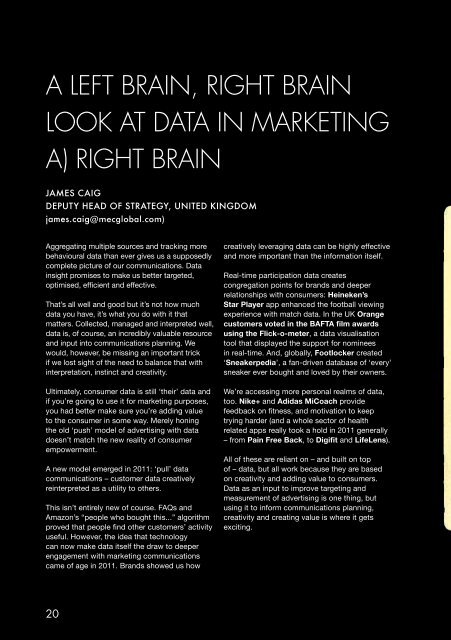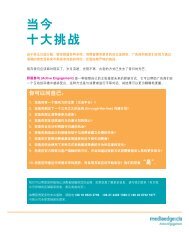IntroductIon - MEC
IntroductIon - MEC
IntroductIon - MEC
You also want an ePaper? Increase the reach of your titles
YUMPU automatically turns print PDFs into web optimized ePapers that Google loves.
A left brAIn, rIght brAIn<br />
look At dAtA In mArketIng<br />
A) rIght brAIn<br />
JaMeS caiG<br />
dePuty Head of StrateGy, united KinGdoM<br />
james.caig@mecglobal.com)<br />
Aggregating multiple sources and tracking more<br />
behavioural data than ever gives us a supposedly<br />
complete picture of our communications. Data<br />
insight promises to make us better targeted,<br />
optimised, efficient and effective.<br />
That’s all well and good but it’s not how much<br />
data you have, it’s what you do with it that<br />
matters. Collected, managed and interpreted well,<br />
data is, of course, an incredibly valuable resource<br />
and input into communications planning. We<br />
would, however, be missing an important trick<br />
if we lost sight of the need to balance that with<br />
interpretation, instinct and creativity.<br />
Ultimately, consumer data is still ‘their’ data and<br />
if you’re going to use it for marketing purposes,<br />
you had better make sure you’re adding value<br />
to the consumer in some way. Merely honing<br />
the old ‘push’ model of advertising with data<br />
doesn’t match the new reality of consumer<br />
empowerment.<br />
A new model emerged in 2011: ‘pull’ data<br />
communications – customer data creatively<br />
reinterpreted as a utility to others.<br />
This isn’t entirely new of course. FAQs and<br />
Amazon’s “people who bought this...” algorithm<br />
proved that people find other customers’ activity<br />
useful. However, the idea that technology<br />
can now make data itself the draw to deeper<br />
engagement with marketing communications<br />
came of age in 2011. Brands showed us how<br />
creatively leveraging data can be highly effective<br />
and more important than the information itself.<br />
Real-time participation data creates<br />
congregation points for brands and deeper<br />
relationships with consumers: Heineken’s<br />
Star Player app enhanced the football viewing<br />
experience with match data. In the UK Orange<br />
customers voted in the BAFTA film awards<br />
using the Flick-o-meter, a data visualisation<br />
tool that displayed the support for nominees<br />
in real-time. And, globally, Footlocker created<br />
‘Sneakerpedia’, a fan-driven database of ‘every’<br />
sneaker ever bought and loved by their owners.<br />
We’re accessing more personal realms of data,<br />
too. Nike+ and Adidas MiCoach provide<br />
feedback on fitness, and motivation to keep<br />
trying harder (and a whole sector of health<br />
related apps really took a hold in 2011 generally<br />
– from Pain Free Back, to Digifit and LifeLens).<br />
All of these are reliant on – and built on top<br />
of – data, but all work because they are based<br />
on creativity and adding value to consumers.<br />
Data as an input to improve targeting and<br />
measurement of advertising is one thing, but<br />
using it to inform communications planning,<br />
creativity and creating value is where it gets<br />
exciting.<br />
20 21




